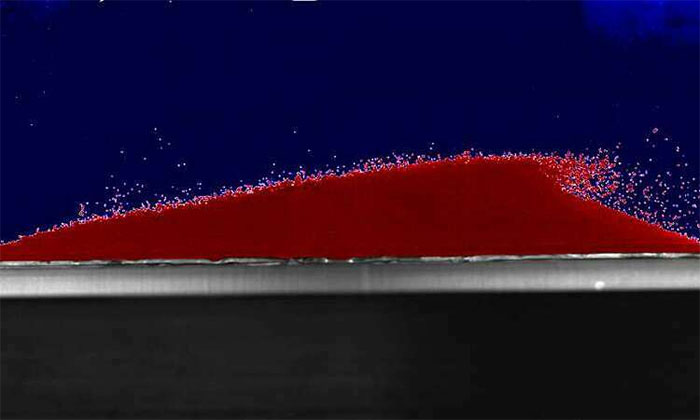Sand dunes can 'communicate' with each other
Sand dunes in front create turbulence affecting rear sand dunes, causing two sand dunes to move with the same frequency and shape.
Despite being inanimate, sand dunes can "communicate" with each other in the interpretation of the scientists. A team from Cambridge University found that when they created motion, the dunes interacted and repelled the adjacent dunes at the lower part of the sand mass.
Using a test dune, the researchers observed that the two identical dunes would initially move closer to each other, but over time they became more and more distant from each other. This interaction is controlled by chaotic vortices from the moving sand dunes, pushing the remaining sand dunes downstream. The results reported in the journal Physical Assessment help to study the movement of sand dunes in the long run, the increase in desertification that can bury infrastructure.
When a block of sand is exposed to wind or water, it forms a sand dune and will move downstream. Sand dunes, whether in the desert, on the riverbed or in the sea, rarely form individually but often appear in large groups, forming large clusters called "dune fields" or "corridors". sand". The movement speed of sand dunes is inversely proportional to its size: small sand dunes move faster and larger sand dunes move slower.

Using a high-speed camera, the researchers were able to track the movement of the sand dune.(Photo: University of Cambridge).
Dr. Karol Bacik, author of the research, works at Cambridge University's Department of Applied Mathematics and Theoretical Physics, said there are many different theories about the interaction of sand dunes. Dunes of different sizes will collide continuously until they form a giant sand dune, a phenomenon that has not been observed in nature. Another theory is that sand dunes can collide and exchange mass, just like billiard balls bouncing one another until they are the same size and move at the same speed.
Dr Nathalie Vriend, who led the research, said that previously used digital methods to model the behavior of sand dunes. But Vriend and the members of her lab designed and built a unique testing system that allowed them to observe the dune behavior. Cambridge researchers used high-speed cameras to track the flow and movement of individual particles in the sand dune.
The two sand dunes begin to move with the same frequency and shape. When the flow begins to move through the two sand dunes, they begin to move."Because the speed of a dune is related to its height, we expect the two dunes to move at the same speed," Vriend said. Initially, the front sand dunes moved faster than the rear sand dunes, but as the experiment continued, the front sand dunes began to slow down until the two sand dunes moved at nearly the same speed.
Observing the flow pattern through the two sand dunes shows that the current is skewed by the sand dune in front, creating a vortex on the sand behind and pushing it away. Sand dunes in front create turbulence affecting the rear sand dunes. As the experiment continued, the dunes grew farther and farther apart, until they formed equilibrium in opposite directions, 180 degrees apart.
The scientists said they will study the extent of the movement of large and complex sand dunes in the deserts. By monitoring dune clusters over a long period of time, it is possible to devise a diversion of the dunes' movement to minimize the impact.
- Explore the world-like sand dunes in Thousand and One Nights in Japan
- The mystery "sand dunes can sing"
- 70km of sand dunes date from the mysterious preserved Ice Age at the bottom of the sea
- Sand dunes on Titan are exactly the same on Earth
- What do the ghost dunes on Mars reveal about life?
- Mysterious blue sand dunes on Mars
- 5 threats to coastal sand dunes
- Sand dunes are leeches on Mars
- The culprit follows extruded sand dunes like the seabed
- Explore the world-like sand hill in Thousand and One Nights in Japan
- Decipher the mystery of the Morse code message on Mars
- Spectacular waves on the rocky mountains
- Sand dunes appear dense at Nha Trang beach
- Detailing the Moon's sand dunes Saturn
 'Fine laughs' - Scary and painful torture in ancient times
'Fine laughs' - Scary and painful torture in ancient times The sequence of numbers 142857 of the Egyptian pyramids is known as the strangest number in the world - Why?
The sequence of numbers 142857 of the Egyptian pyramids is known as the strangest number in the world - Why? History of the iron
History of the iron What is alum?
What is alum?